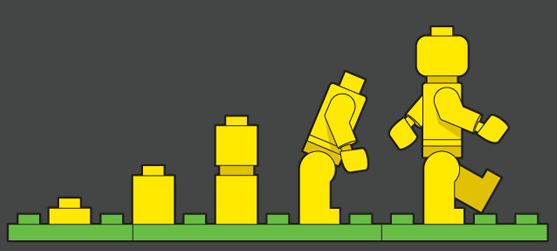When Darwin wrote The Origin of Species in 1859, chances are he wasn’t thinking about anything beyond biological evolution. Yet Darwin’s simple, brilliant theory has impacted everything from economic models and professional development to startup methodology and machine learning.
Much like John Nash’s Equilibrium Points in N-Person Games, which forced the world to rethink what it knew about chance and decision-making, Darwin’s theory of evolution has forced the world to rethink learning, development, and growth. Startups are especially indebted.
Let’s take a look at 5 examples of product design evolution (from the point of view of a startup) and what we can learn from them about making better products.
1. Minimum Viable Product = Unicellular organism
If the unprecedented, record-shattering success of companies like Lego and Mojang AB (developer of Minecraft) tell us anything, it’s that creating a minimum viable product (MVP) is an essential first step in the development of any product worth making (and worth buying).
Markus “Notch” Persson is a classic case study of a bootstrapped startup tied to one and only one product that succeeded beyond anyone’s wildest dreams. Microsoft bought Mojang AB for $2.5 billion in 2014 — making Minecraft one of the most valuable games of all time.
And Minecraft’s awe-inspiring growth, from its first beta (in which players could only interact with blocks to build things) to the massive, sprawling multi-server sensation it is today, is very similar to the growth of a unicellular organism into a multicellular organism. The trick is that you must start with one stable cell (i.e., the MVP).
Natural Selection Says: “No archaea is born a eukaryote.”
2. Iteration = Microevolution
A company famous for its quick, compulsive iterations and consistent success is Google.
Famous for its 20% time policy, which founders Larry Page and Sergey Brin cited as crucial to the company’s success, Googlers created daily conveniences like Gmail and Adsense in time that was theirs alone to create, fail, iterate, and innovate — which I like to think of as “encouraged evolution.”
Google management’s recent push to cut down on 20% time is probably not their wisest business move. But critics who are focusing on the executive decision are missing the forest for the trees.
As long as the idea of 20% time exists, Googlers will continue to microevolve and refine Google’s products, which effectively gives Google’s products extra rounds of natural selection on the competition.
Natural Selection Says: “Iterate. The way of the future. Iterate. The way of the future.”
3. Pivoting = Macroevolution
Another company famous for its innovations is Amazon, which is probably the most high-profile example of successful pivoting in the world (a title formerly held by Berkshire Hathaway, originally a clothier).
We all remember Amazon as that spunky online bookseller that wanted to take on Barnes & Noble and Borders. Fast forward 21 years, and Amazon’s done just that. Borders is gone and Barnes & Noble will never regain its first place position in the bookseller market again.
But what’s far more interesting than Amazon’s current success is how it arrived there. Would anyone have imagined that a bookseller would become the world’s premiere ecommerce website, warehouse, and shipper? That it would revolutionize book-reading (e.g., Kindle), but also branch out into groceries, gaming, streaming video, and more?
Of course we couldn’t have imagined this. That’s because we can’t evolve by leaps and bounds in one lifetime. But natural selection would have seen Amazon’s success coming from a mile away.
Natural Selection Says: “Pivot or hit a wall at speed.”
4. Failing Fast = Natural Selection
The world needs to thank Eric Ries for writing The Lean Startup and kicking off the flagship movement for tech innovation. Failing fast is now a red badge of courage. Companies like Lean Startup Machine even help teach startups how to fail faster.
Truthfully, we humans are imperfect product designers because we become too emotionally invested in our products. There are countless examples of high-profile products that went nowhere while leeching a company’s financial reserves. Think AOL CEO Tim Armstrong’s Patch, or even Google Glass in 2015.
No matter how experienced we are at failure, we still make for terrible judges of potential success. Which is why the lean startup movement is so important for product design. It’s the much-needed marriage of the scientific method to the making and selling of products. Fragile human egos shouldn’t be the final determinant for how and when products are made.
Natural Selection Says: “We fall down so we can learn to pick ourselves up again.”
5. Actually Failing = Extinction?
The best part about being a startup founder or product designer today, however, has nothing to do with evolutionary theory at all. In fact, it flies in the face of natural evolution.
I’m talking about extinction, which pretty much can’t happen to a great idea or a great product anymore. Ideas and products can be abandoned due to financial or emotional hardships, but they can always be picked back up again.
If you don’t believe me, just take a look at what an older, slightly humbler, more experienced Steve Jobs did when he came back to an endangered Apple in 2007.
Natural Selection Says: “If at first you can’t succeed, try, try again.”
Evolving Towards Perfectly Efficient Product Design
An optimist might look at the various ways startups and their products have evolved over the past few decades and conclude that, one day in a bright, rosy future, product design will reach a point of perfect efficiency.
Perhaps machine-assisted product design will do away with the last vestiges of inefficiency by 2050. Or maybe product designers will learn to shed their egos by 2100.
In any case, we are heading in the right direction. Let’s all keep going that way.








